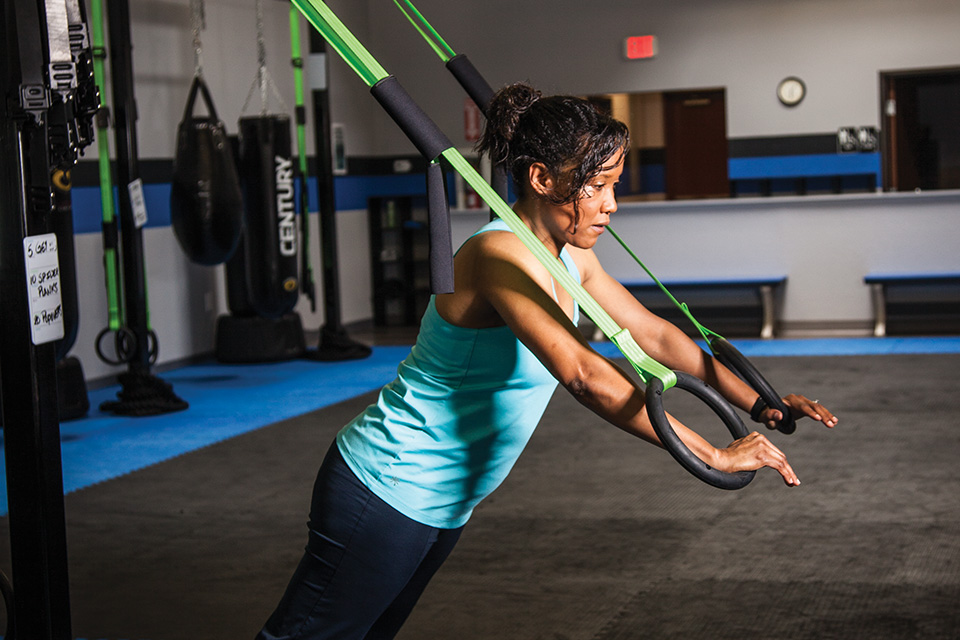Workout: Push It!

Many people dread the push-up. And rightly so. It’s been the test of upper body strength since elementary school when we were forced to take the President’s Physical Fitness Test—of which, many of us “failed.” As a trainer, I often hear clients say that they just can’t do push-ups. To which I respond by prescribing what? Push-ups. The fact of the matter is, upper body “pushing” movements allow you to gain strength and develop muscle tone for shape. That’s why professional trainers (whose job it is to get you the results you want) won’t let you off the hook and still demand long-standing, body weight calisthenics. For those getting over the push-up hump who feel confident to start challenging themselves with other pushing and pressing movements, we have an upper-body challenge circuit just for you.
Using the traditional push-up as an upper-body strength benchmark, start individually testing out the following movements—taking as much recovery as needed. Test out the following circuit to engage your upper-body power and help strengthen your core and shoulder joint stability.
Rotational Push-Up

Purpose: To challenge the body by moving through multiple planes of motion—from prone position (sagittal plane) to transition movement (transverse plane) to the T-position on the side of the body (frontal plane). This creates great movement and stability work for each shoulder.
Start: In the push-up position with feet shoulder-width apart to allow a full turn onto the sides of the feet.
Perform a push and then begin your rotational movement as you push-up from the floor.
Rotate the body onto a single arm, turn the hips, and follow through by completely finishing on the lateral edges of both shoes. Create a “T” position on your side.
Return to push-up position slow and controlled. Maintain control all the way down until the hand is replaced on the ground just under the shoulder.
Tweak Up: Perform the Rotational Push-Up with speed.
Suspended Push-Ups

Purpose: Choose suspension straps to increase stability demands but also allow a self-adjusted intensity with the lever arm created by the foot placement.
Start: In a push-up position, with your hands firmly gripping the suspension handle or rings. Make sure that your core is engaged nice and stiff making a straight line through the shoulder, hip, and ankle.
Slowly lower your body, maintaining alignment, and brining your upper arms to about 45 degrees away from the torso.
Keep your shoulders away from your ears. Once your hands have reached a position equal to the height of the torso, maintain an engaged core and press back up to the start position.
Push Press with Kettle Bells

Purpose: To add some power to this circuit with a focus on overhead pressing ability.
Start: Standing tall with the kettle bells in a front rack position and arms against the body with vertical forearm position. Make sure knuckles are pointed to the ceiling with a neutral wrist.
Brace the core—as if you anticipate someone punching you in the stomach—and then quickly perform a quick dip or small bend in the hips to load the movement.
Immediately follow this with a fast drive or extension of the hips (dip and drive). This starts the movement of the kettle bells using the body.
As the kettle bells travel up, press up by extending the elbows and flexing the shoulders until the arms create a straight line over the shoulder.
Pause to own control of the finish and then slowly lower them under control to the start position.
Explosive Push-Up

Purpose: To express great push-up position and power relative to the individual, especially after the accumulating fatigue from the previous three
Start: In plank position of the push up with feet shoulder-width apart and a neutral spine.
While keeping the back flat, lower the body quickly and evenly by using a short, quick bend in the elbows and shoulders.
Follow this immediately by a quick unbending action and extension of the elbows.
The force is produced with the intention of moving as fast as possible through this dip and drive movement of the upper body. Finish with hands coming slightly off the ground.
Make sure that nothing in the torso position or lower body position changes.
As you return to the ground, absorb the force under control.
Reset to the top plank position and repeat.
The added variety of this circuit will help you bypass the dread of doing upper-body pushing exercises to build strength. Make sure you master each movement by itself before putting them all together. And remember, the stronger you are with your upper-body, the more total body metabolic workouts you will be able to accomplish.






